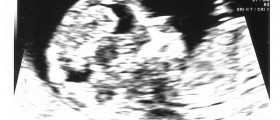
Sometimes, this kind of pregnancy is also called a missed miscarriage or a silent miscarriage. That is quite an accurate description. During a blighted ovum, a fertilized egg makes its way to the uterus and starts nestling into the uterine wall as it would with any pregnancy, but no embryo develops. The embryo that was initially created usually has chromosomal problems, and when the body detects these in the first few days after a pregnancy is established, it no longer continues to develop. An anembryonic pregnancy can be diagnosed through an early ultrasound. During such a scan, an amniotic sac will become visible, but no baby will be inside it. It is not uncommon for a diagnosis to be made after a woman already started showing signs of miscarriage, like vaginal bleeding and abdominal cramping or pain.
These complaints can be the exact reason an early ultrasound was recommended. But in some cases, these pregnancies can go on for quite a while and they could be discovered by chance at a routine ultrasound. After the diagnosis is made, women will have the choice of either waiting for a miscarriage to occur naturally, or to undergo a D&C. You can talk through these options with your doctor, and you do not have to make the decision immediately after diagnosis.

















Your thoughts on this
Loading...